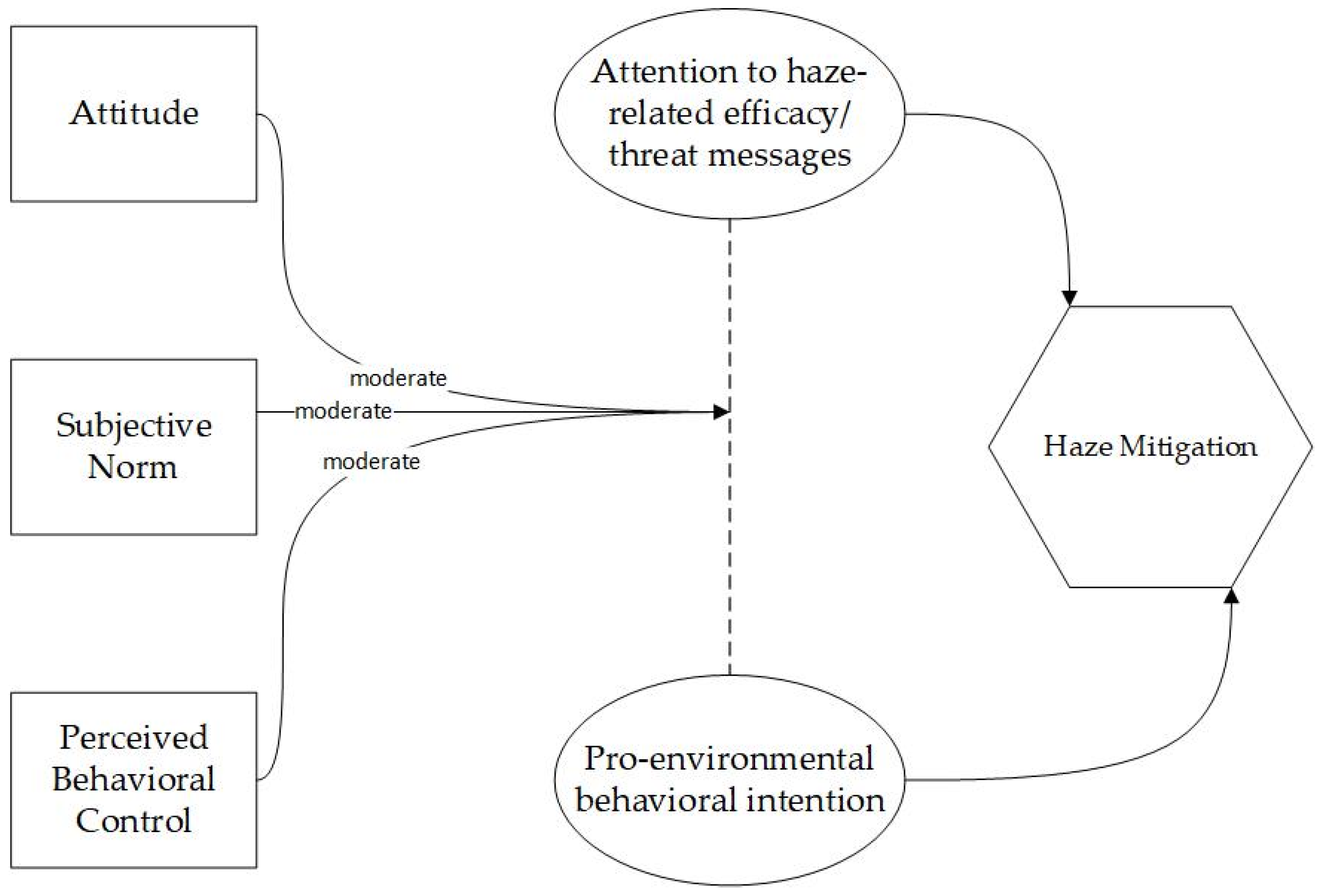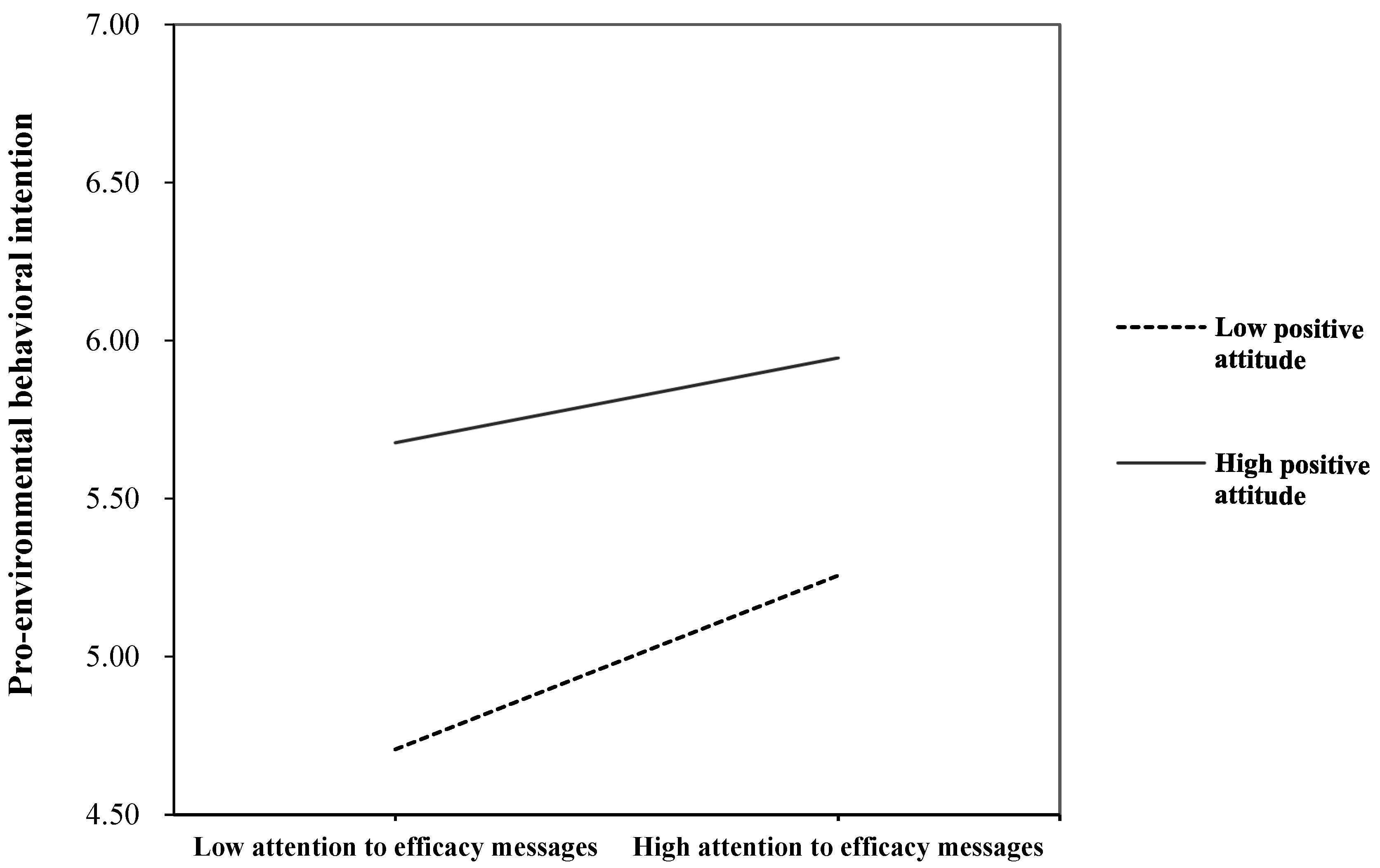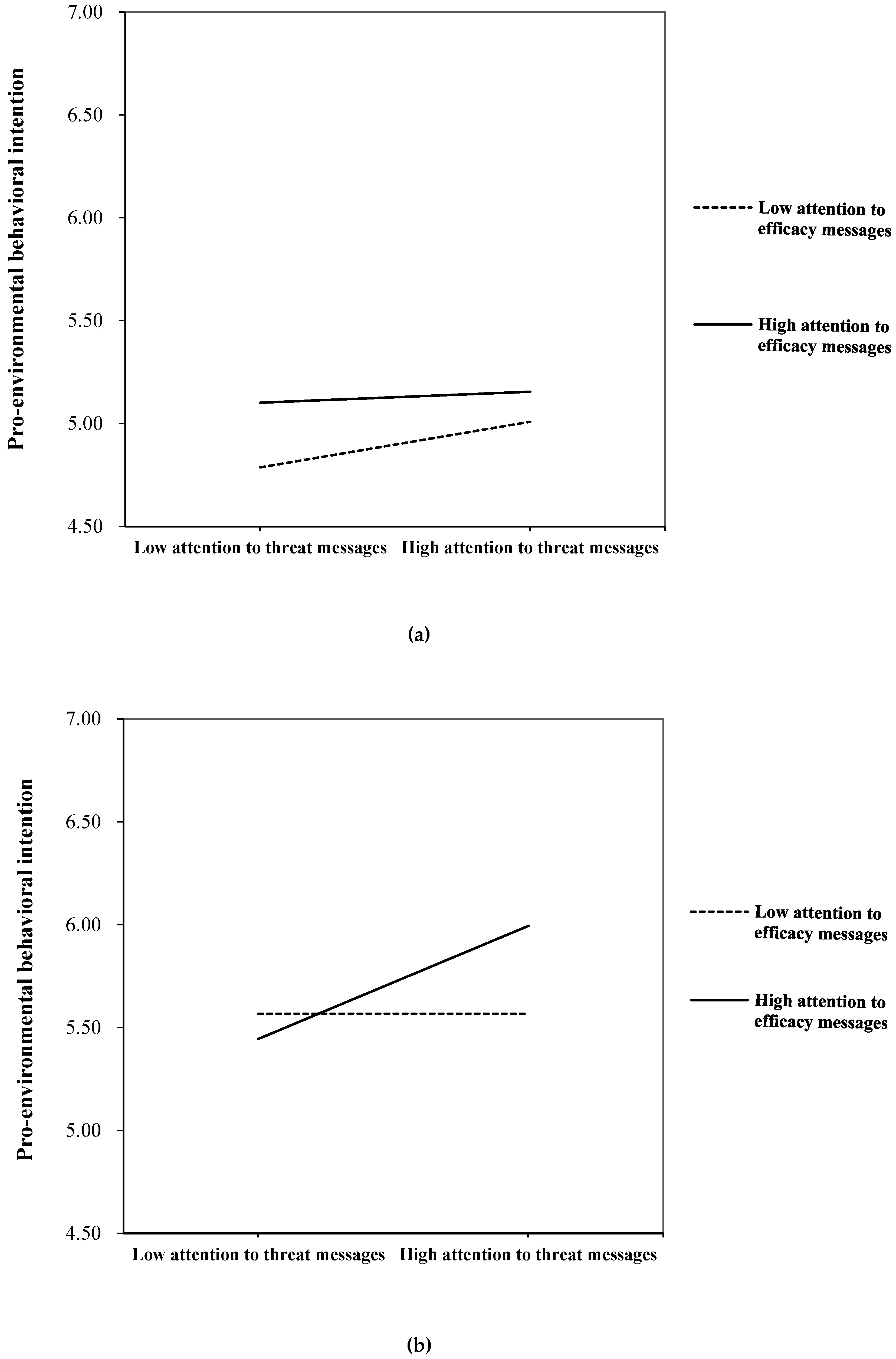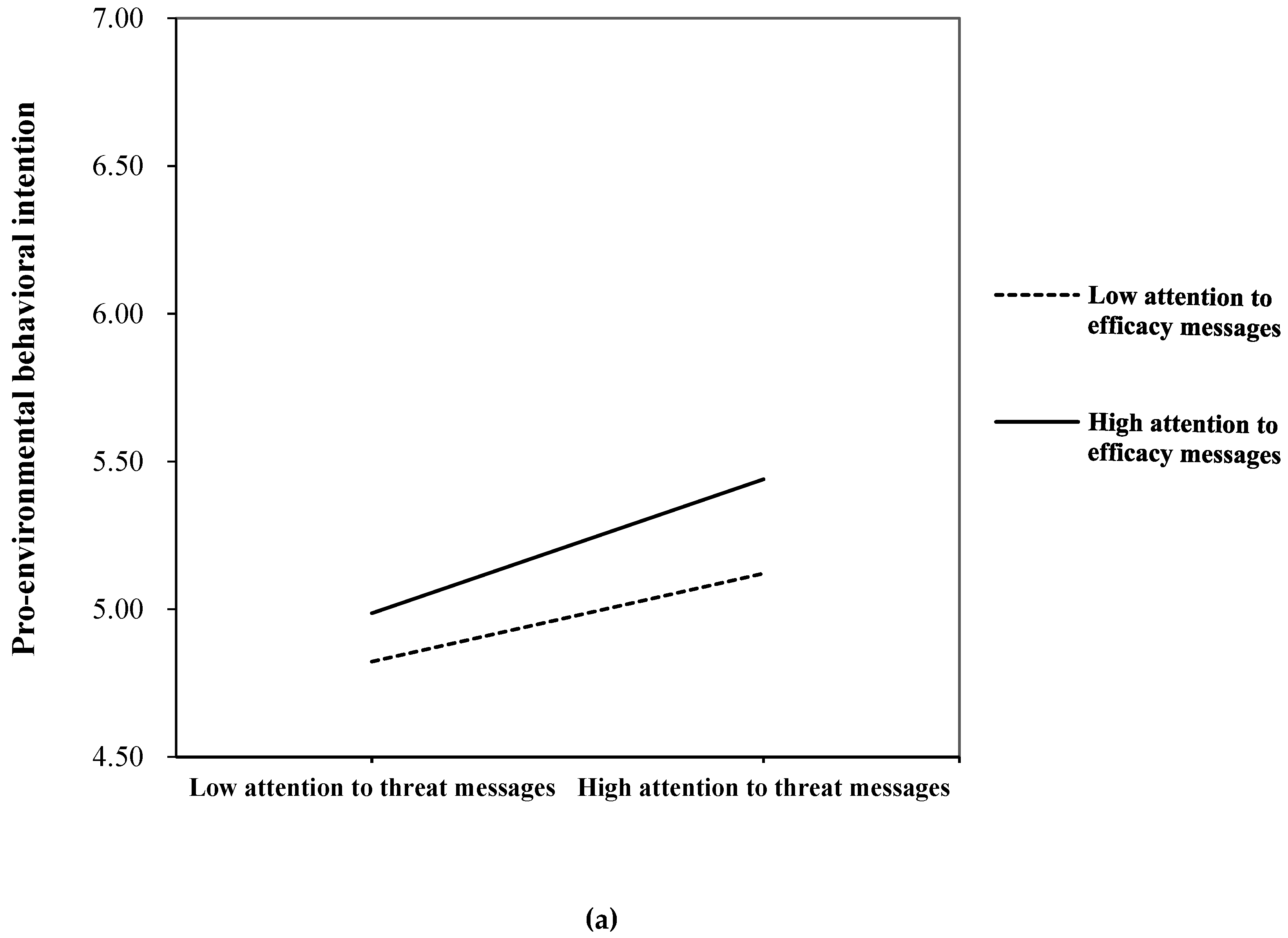Personal and Media Factors Related to Citizens’ Pro-environmental Behavioral Intention against Haze in China: A Moderating Analysis of TPB
Abstract
:1. Introduction
2. Literature Review and Research Hypotheses
2.1. Pro-Environmental Behavioral Intention
2.2. Personal Factors
2.3. Media Factors
2.4. Interaction of Personal and Media Factors
3. Methods
3.1. Data Collection
3.2. Sample
3.3. Measures
3.4. Data Analysis
4. Results
4.1. Personal Factors Related to Pro-Environmental Behavioral Intention
4.2. Media Factors Related to Pro-environmental Behavioral Intention
4.3. Interaction Effects
5. Discussion
6. Theoretical and Practical Implications
7. Limitations and Future Research Directions
8. Conclusions
Author Contributions
Funding
Conflicts of Interest
References
- Ministry of Environment of China. The Annual Report of China’s Environment Status in 2018. 2019. Available online: http://202.194.1.97/cache/12/03/www.mee.gov.cn/bfdd06cb75360fa167033d504081e357/P020190619587632630618.pdf (accessed on 6 January 2020).
- Li, M.; Zhang, L. Haze in China: Current and future challenges. Environ. Pollut. 2014, 189, 85–86. [Google Scholar] [CrossRef] [PubMed]
- Shi, H.; Fan, J.; Zhao, D. Predicting household PM2.5-reduction behavior in Chinese urban areas: An integrative model of Theory of Planned Behavior and Norm Activation Theory. J. Clean. Prod. 2017, 145, 64–73. [Google Scholar] [CrossRef]
- Ajzen, I. The theory of planned behavior. Organ. Behave. Hum. Decis. Processes 1991, 50, 179–211. [Google Scholar] [CrossRef]
- Chan, L.; Bishop, B. A moral basis for recycling: Extending the theory of planned behaviour. J. Environ. Psychol. 2013, 36, 96–102. [Google Scholar] [CrossRef] [Green Version]
- Sparks, P.; Shepherd, R. Self-Identity and the Theory of Planned Behavior: Assesing the Role of Identification with “Green Consumerism”. Soc. Psychol. Q. 1992, 55, 388. [Google Scholar] [CrossRef]
- Banerjee, S.; Ho, S.S. Applying the theory of planned behavior: Examining how communication, attitudes, social norms, and perceived behavioral control relate to healthy lifestyle intention in Singapore. Int. J. Health. Manag. 2019, 1–8. [Google Scholar] [CrossRef] [Green Version]
- Ho, S.S.; Liao, Y.; Rosenthal, S. Applying the Theory of Planned Behavior and Media Dependency Theory: Predictors of Public Pro-environmental Behavioral Intentions in Singapore. Environ. Commun. 2014, 9, 77–99. [Google Scholar] [CrossRef]
- Namkoong, K.; Nah, S.; Record, R.A.; Van Stee, S.K. Communication, Reasoning, and Planned Behaviors: Unveiling the Effect of Interactive Communication in an Anti-Smoking Social Media Campaign. Heal. Commun. 2016, 32, 41–50. [Google Scholar] [CrossRef]
- Paek, H.J.; Oh, H.J.; Hove, T. How media campaigns influence children’s physical activity: Expanding the normative mechanisms of the theory of planned behavior. J. Health Commun. 2012, 17, 869–885. [Google Scholar] [CrossRef]
- Chen, L.; Yang, X. Using EPPM to Evaluate the Effectiveness of Fear Appeal Messages Across Different Media Outlets to Increase the Intention of Breast Self-Examination Among Chinese Women. Heal. Commun. 2018, 34, 1369–1376. [Google Scholar] [CrossRef]
- So, J. A Further Extension of the Extended Parallel Process Model (E-EPPM): Implications of Cognitive Appraisal Theory of Emotion and Dispositional Coping Style. Heal. Commun. 2013, 28, 72–83. [Google Scholar] [CrossRef]
- Witte, K. Fear control and danger control: A test of the extended parallel process model (EPPM). Commun. Monogr. 1994, 61, 113–134. [Google Scholar] [CrossRef]
- Witte, K. Putting the fear back into fear appeals: The extended parallel process model. Commun. Monogr. 1992, 59, 329–349. [Google Scholar] [CrossRef]
- McGuire, W. Input and output variables currently promising for constructing persuasive communications. In Public Communication Campaigns, 3rd ed.; Rice, R.E., Atkin, C.K., Eds.; Sage: Thousand Oaks, CA, USA, 2001; pp. 22–48. [Google Scholar]
- Atkin, C.K.; Rice, R.E. Theory and Principles of Public Communication Campaigns. Public Commun. Campaigns 2013, 4, 3–20. [Google Scholar]
- Napper, L.E.; Harris, P.; Klein, W. Combining Self-Affirmation with the Extended Parallel Process Model: The Consequences for Motivation to Eat More Fruit and Vegetables. Heal. Commun. 2013, 29, 610–618. [Google Scholar] [CrossRef]
- Xue, W.; Hine, D.W.; Marks, A.; Phillips, W.; Nunn, P.D.; Zhao, S. Combining threat and efficacy messaging to increase public engagement with climate change in Beijing, China. Clim. Chang. 2016, 137, 43–55. [Google Scholar] [CrossRef]
- Lee, K. The role of media exposure, social exposure and biospheric value orientation in the environmental attitude-intention-behavior model in adolescents. J. Environ. Psychol. 2011, 31, 301–308. [Google Scholar] [CrossRef]
- Liao, Y.; Ho, S.S.; Yang, X. Motivators of pro-environmental behavior: Examining the underlying processes in the influence of presumed media influence model. Sci. Commun. 2016, 38, 51–73. [Google Scholar] [CrossRef]
- Burgess, J.; Harrison, C.M.; Filius, P. Environmental Communication and the Cultural Politics of Environmental Citizenship. Environ. Plan. A Econ. Space 1998, 30, 1445–1460. [Google Scholar] [CrossRef] [Green Version]
- Mazur, A.; Lee, J. Sounding the Global Alarm: Environmental Issues in the US National News. Soc. Stud. Sci. 1993, 23, 681–720. [Google Scholar] [CrossRef]
- Stamm, K.R.; Clark, F.; Eblacas, P.R. Mass communication and public understanding of environmental problems: The case of global warming. Public Underst. Sci. 2000, 9, 219–238. [Google Scholar] [CrossRef] [Green Version]
- Yang, X.; Ho, S.S. Decreasing the knowledge gap among different socioeconomic status groups on the issue of climate change. Environ. Hazards 2017, 16, 276–290. [Google Scholar] [CrossRef]
- De Leeuw, A.; Valois, P.; Ajzen, I.; Schmidt, P. Using the theory of planned behavior to identify key beliefs underlying pro-environmental behavior in high-school students: Implications for educational interventions. J. Environ. Psychol. 2015, 42, 128–138. [Google Scholar] [CrossRef]
- Greaves, M.; Zibarras, L.D.; Stride, C. Using the theory of planned behavior to explore environmental behavioral intentions in the workplace. J. Environ. Psychol. 2013, 34, 109–120. [Google Scholar] [CrossRef]
- Armitage, C.J.; Conner, M. Efficacy of the theory of planned behaviour: A meta-analytic review. Br. J. Soc. Psychol. 2001, 40, 471–499. [Google Scholar] [CrossRef] [Green Version]
- Guo, J.; Wang, T.; Liao, J.; Huang, C. Efficacy of the theory of planned behavior in predicting breastfeeding: Meta-analysis and structural equation modeling. Appl. Nurs. Res. 2016, 29, 37–42. [Google Scholar] [CrossRef]
- Clark, C.F.; Kotchen, M.J.; Moore, M.R. Internal and external influences on pro-environmental behavior: Participation in a green electricity program. J. Environ. Psychol. 2003, 23, 237–246. [Google Scholar] [CrossRef]
- Fujii, S. Environmental concern, attitude toward frugality, and ease of behavior as determinants of pro-environmental behavior intentions. J. Environ. Psychol. 2006, 26, 262–268. [Google Scholar] [CrossRef]
- Sia, A.P.; Hungerford, H.R.; Tomera, A.N. Selected Predictors of Responsible Environmental Behavior: An Analysis. J. Environ. Educ. 1986, 17, 31–40. [Google Scholar] [CrossRef]
- Bamberg, S.; Möser, G. Twenty years after Hines, Hungerford, and Tomera: A new meta-analysis of psycho-social determinants of pro-environmental behaviour. J. Environ. Psychol. 2007, 27, 14–25. [Google Scholar] [CrossRef]
- Fielding, K.; McDonald, R.; Louis, W. Theory of planned behaviour, identity and intentions to engage in environmental activism. J. Environ. Psychol. 2008, 28, 318–326. [Google Scholar] [CrossRef]
- Whitmarsh, L.; O’Neill, S. Green identity, green living? The role of pro-environmental self-identity in determining consistency across diverse pro-environmental behaviours. J. Environ. Psychol. 2010, 30, 305–314. [Google Scholar] [CrossRef]
- Bamberg, S.; Hunecke, M.; Blöbaum, A. Social context, personal norms and the use of public transportation: Two field studies. J. Environ. Psychol. 2007, 27, 190–203. [Google Scholar] [CrossRef]
- Cialdini, R.B.; Reno, R.R.; Kallgren, C.A. A focus theory of normative conduct: Recycling the concept of norms to reduce littering in public places. J. Personal. Soc. Psychol. 1990, 58, 1015. [Google Scholar] [CrossRef]
- Bandura, A. Self-efficacy mechanism in human agency. Am. Psychol. 1982, 37, 122. [Google Scholar] [CrossRef]
- Bandura, A. Social cognitive theory in cultural context. Appl. Psychol. 2002, 51, 269–290. [Google Scholar] [CrossRef]
- Hungerford, H.R.; Volk, T.L. Changing Learner Behavior through Environmental Education. J. Environ. Educ. 1990, 21, 8–21. [Google Scholar] [CrossRef]
- Zhao, X. Media use and global warming perceptions: A snapshot of the reinforcing spirals. Commun. Res. 2009, 36, 698–723. [Google Scholar] [CrossRef]
- Rogers, R.W. A Protection Motivation Theory of Fear Appeals and Attitude Change1. J. Psychol. 1975, 91, 93–114. [Google Scholar] [CrossRef]
- Robberson, M.R.; Rogers, R.W. Beyond Fear Appeals: Negative and Positive Persuasive Appeals to Health and Self-Esteem. J. Appl. Soc. Psychol. 1988, 18, 277–287. [Google Scholar] [CrossRef]
- Weberling, B.; McKeever, B. Framing breast cancer: Building an agenda through online advocacy and fundraising. Public Relations Rev. 2012, 38, 108–115. [Google Scholar] [CrossRef]
- Dillard, J.; Nabi, R.L. The Persuasive Influence of Emotion in Cancer Prevention and Detection Messages. J. Commun. 2006, 56, S123–S139. [Google Scholar] [CrossRef]
- Weinstein, N.; Rogerson, M.; Moreton, J.; Balmford, A.; Bradbury, R. Conserving nature out of fear or knowledge? Using threatening versus connecting messages to generate support for environmental causes. J. Nat. Conserv. 2015, 26, 49–55. [Google Scholar] [CrossRef] [Green Version]
- Chaffee, S.H.; Schleuder, J. Measurement and Effects of Attention to Media News. Hum. Commun. Res. 1986, 13, 76–107. [Google Scholar] [CrossRef]
- Ajzen, I. Constructing a TPB Questionnaire: Conceptual and Methodological Considerations. 2006. Available online: http://people.umass.edu/aizen/pdf/tpb.measurement.pdf (accessed on 12 January 2020).
- Park, H.S.; Smith, S.W. Distinctiveness and Influence of Subjective Norms, Personal Descriptive and Injunctive Norms, and Societal Descriptive and Injunctive Norms on Behavioral Intent: A Case of Two Behaviors Critical to Organ Donation. Hum. Commun. Res. 2007, 33, 194–218. [Google Scholar] [CrossRef]
- Snyder, L.B.; Rouse, R.A. The Media Can Have More Than an Impersonal Impact: The Case of AIDS Risk Perceptions and Behavior. Health Commun. 1995, 7, 125–145. [Google Scholar] [CrossRef]
- Chen, M.-F. Self-efficacy or collective efficacy within the cognitive theory of stress model: Which more effectively explains people’s self-reported proenvironmental behavior? J. Environ. Psychol. 2015, 42, 66–75. [Google Scholar] [CrossRef]
- Homburg, A.; Stolberg, A. Explaining pro-environmental behavior with a cognitive theory of stress. J. Environ. Psychol. 2006, 26, 1–14. [Google Scholar] [CrossRef]
- Cohen, P.; West, S.G.; Aiken, L.S. Applied Multiple Regression/Correlation Analysis for the Behavioral Sciences; Psychology Press: London, UK, 2014. [Google Scholar]
- Olson, M. The Logic of Collective Action; Harvard University Press: Cambridge, MA, USA, 1970. [Google Scholar]
- Bočkarjova, M.; Steg, L. Can Protection Motivation Theory predict pro-environmental behavior? Explaining the adoption of electric vehicles in the Netherlands. Glob. Environ. Chang. 2014, 28, 276–288. [Google Scholar] [CrossRef]
- Huang, H. Media use, environmental beliefs, self-efficacy, and pro-environmental behavior. J. Bus. Res. 2016, 69, 2206–2212. [Google Scholar] [CrossRef]
- Witte, K.; Allen, M. A meta-analysis of fear appeals: Implications for effective public health campaigns. Health Educ. Behav. 2000, 27, 591–615. [Google Scholar] [CrossRef] [PubMed]
- Heinrichs, N.; Rapee, R.M.; Alden, L.A.; Bögels, S.; Hofmann, S.G.; Oh, K.J.; Sakano, Y. Cultural differences in perceived social norms and social anxiety. Behav. Res. Ther. 2006, 44, 1187–1197. [Google Scholar] [CrossRef] [PubMed]
- Schreier, S.-S.; Heinrichs, N.; Alden, L.; Rapee, R.M.; Hofmann, S.G.; Chen, J.; Oh, K.J.; Bögels, S. Social anxiety and social norms in individualistic and collectivistic countries. Depression Anxiety 2010, 27, 1128–1134. [Google Scholar] [CrossRef] [PubMed] [Green Version]
- Lewis, I.; Watson, B.; White, K.M. Extending the Explanatory Utility of the EPPM beyond Fear-Based Persuasion. Heal. Commun. 2013, 28, 84–98. [Google Scholar] [CrossRef] [PubMed] [Green Version]
- Lam, S.-P. Predicting Intention to Save Water: Theory of Planned Behavior, Response Efficacy, Vulnerability, and Perceived Efficiency of Alternative Solutions. J. Appl. Soc. Psychol. 2006, 36, 2803–2824. [Google Scholar] [CrossRef]
- Lin, S.-P. The gap between global issues and personal behaviors: Pro-environmental behaviors of citizens toward climate change in Kaohsiung, Taiwan. Mitig. Adapt. Strat. Glob. Chang. 2012, 18, 773–783. [Google Scholar] [CrossRef] [Green Version]





| 1 | 2 | 3 | 4 | 5 | 6 | 7 | 8 | 9 | |
|---|---|---|---|---|---|---|---|---|---|
| 1. Age | ---- | ||||||||
| 2. Gender | −0.07 | ||||||||
| 3. Education | −0.19 ** | −0.08 | |||||||
| 4. Income | 0.12 * | −0.17 ** | 0.18 *** | ||||||
| 5. Attitude | 0.17 ** | 0.14 ** | −0.03 | −0.003 | |||||
| 6. Social norms | 0.16 ** | −0.04 | 0.01 | 0.06 | 0.47 *** | ||||
| 7. Perceived behavioral control | 0.15 ** | 0.04 | 0.03 | 0.05 | 0.61 *** | 0.68 *** | |||
| 8. Attention to efficacy messages | 0.08 | −0.01 | −0.02 | 0.05 | 0.29 *** | −0.28 *** | 0.27 *** | ||
| 9. Attention to threat messages | 0.03 | 0.01 | −0.07 | 0.12 * | 0.34 *** | 0.37 *** | 0.40 *** | 0.70 *** | |
| 10. Pro-environmental behavioral intention | 0.16 ** | 0.07 | 0.001 | −0.002 | 0.60 *** | 0.54 *** | 0.59 *** | 0.32 *** | 0.32 *** |
| Zero-order | Model 1 | Model 2 | Model 3 | Model 4 | Model 5 | |
|---|---|---|---|---|---|---|
| Block 1: Demographic variables | ||||||
| Age | 0.16 ** | 0.18 *** | 0.04 | 0.05 | 0.05 | 0.04 |
| Gender | 0.07 | 0.08 | 0.02 | 0.03 | 0.04 | 0.04 |
| Education | 0.001 | 0.05 | 0.02 | 0.02 | 0.01 | 0.01 |
| Income | −0.002 | −0.03 | −0.03 | −0.03 | −0.03 | −0.03 |
| Incremental R (%) | 3.50 *** | |||||
| Block 2: TPB variables | ||||||
| Attitude | 0.60 *** | 0.36 *** | 0.34 *** | 0.29 *** | 0.27 *** | |
| Social norms | 0.54 *** | 0.22 *** | 0.21 *** | 0.22 *** | 0.19 ** | |
| Perceived behavioral control | 0.60 *** | 0.22 *** | 0.22 *** | 0.25 *** | 0.32 *** | |
| Incremental R (%) | 43.80 *** | |||||
| Block 3: Communication variables | ||||||
| Attention to efficacy messages | 0.32 *** | 0.15 ** | 0.15 ** | 0.16 ** | ||
| Attention to threat messages | 0.32 *** | −0.07 | −0.03 | −0.03 | ||
| Incremental R (%) | 1.30 *** | |||||
| Block 4: Two-way interactions | ||||||
| Efficacy messages *threat messages attention | 0.07 | 0.05 | ||||
| Efficacy messages attention* ATT | −0.15 * | −0.19 * | ||||
| Threat messages attention* ATT | 0.04 | 0.09 | ||||
| Efficacy messages attention* SN | 0.00 | 0.09 | ||||
| Threat messages attention* SN | 0.03 | 0.06 | ||||
| Efficacy messages attention* PBC | 0.08 | 0.02 | ||||
| Threat messages attention* PBC | 0.07 | −0.001 | ||||
| ATT * SN | −0.07 | −0.13 | ||||
| ATT * PBC | 0.004 | 0.04 | ||||
| PBC * SN | 0.04 | 0.09 | ||||
| Incremental R (%) | 2.30 *** | |||||
| Block 5: Three-way interactions | ||||||
| Efficacy messages * Threat messages * ATT | 0.06 | |||||
| Efficacy messages * Threat messages * SN | 0.16 * | |||||
| Efficacy messages * Threat messages * PBC | −0.23 ** | |||||
| Incremental R (%) | 1.40 *** | |||||
| Total R (%) | 52.30 *** |
© 2020 by the authors. Licensee MDPI, Basel, Switzerland. This article is an open access article distributed under the terms and conditions of the Creative Commons Attribution (CC BY) license (http://creativecommons.org/licenses/by/4.0/).
Share and Cite
Yang, X.; Chen, L.; Wei, L.; Su, Q. Personal and Media Factors Related to Citizens’ Pro-environmental Behavioral Intention against Haze in China: A Moderating Analysis of TPB. Int. J. Environ. Res. Public Health 2020, 17, 2314. https://0-doi-org.brum.beds.ac.uk/10.3390/ijerph17072314
Yang X, Chen L, Wei L, Su Q. Personal and Media Factors Related to Citizens’ Pro-environmental Behavioral Intention against Haze in China: A Moderating Analysis of TPB. International Journal of Environmental Research and Public Health. 2020; 17(7):2314. https://0-doi-org.brum.beds.ac.uk/10.3390/ijerph17072314
Chicago/Turabian StyleYang, Xiaodong, Liang Chen, Lai Wei, and Qi Su. 2020. "Personal and Media Factors Related to Citizens’ Pro-environmental Behavioral Intention against Haze in China: A Moderating Analysis of TPB" International Journal of Environmental Research and Public Health 17, no. 7: 2314. https://0-doi-org.brum.beds.ac.uk/10.3390/ijerph17072314





